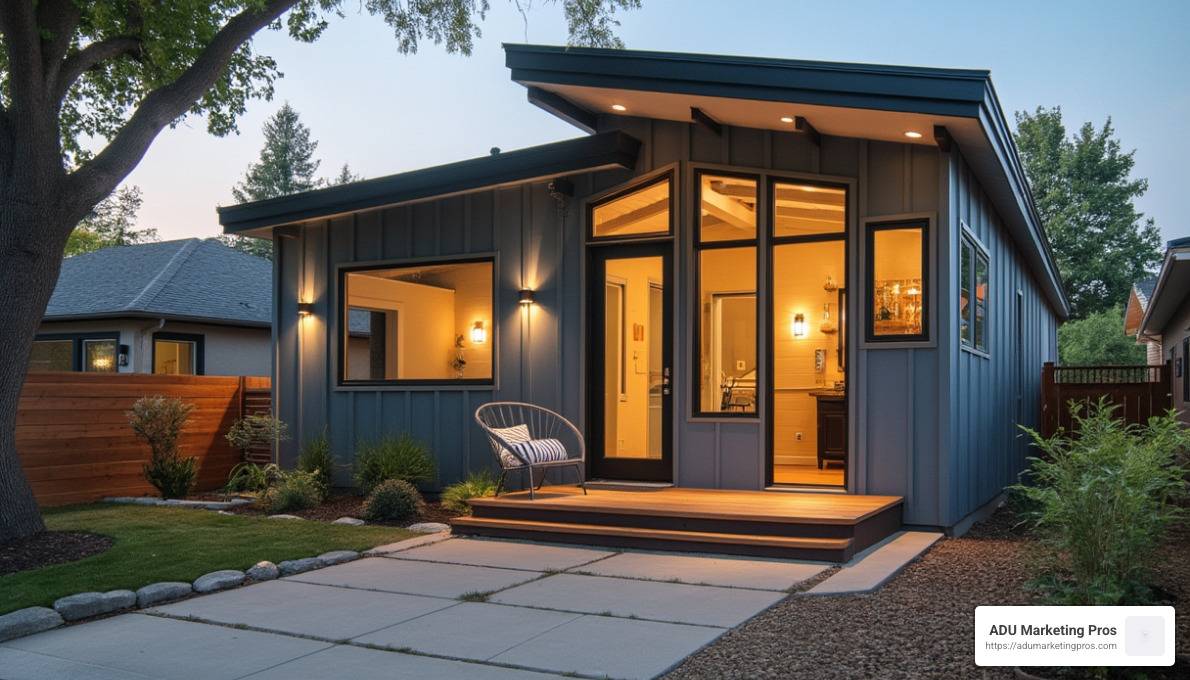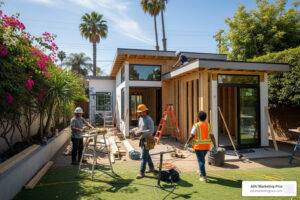Marketing for construction companies of accessory dwelling units (ADU) is pivotal in today’s booming housing sector. As the need for flexible living spaces surges, construction firms are exploring innovative business models to cater to this expanding market. Here’s a snapshot of what’s driving this growth:
- Increased Popularity: ADUs are in demand due to their versatility and utility as rental units or family accommodations.
- Market Growth: Technological advancements, sustainable practices, and smart home integration are accelerating market expansion.
- Diverse Business Models: From prefabricated units to custom builds, companies are leveraging various approaches to meet diverse customer needs.
Accessory Dwelling Units, or ADUs, are experiencing a remarkable rise in popularity. They offer unique solutions for homeowners and developers alike, all powered by evolving market dynamics and consumer needs. ADUs provide the flexibility that today’s housing market demands—whether it’s a spacious granny flat or a chic city studio, there’s an ADU model to fit every requirement.
This surge in demand is fueled by changing regulations that support ADU construction, primarily seen in urban areas like California. As more areas adapt their zoning laws, the market for ADUs continues to grow, offering new opportunities for construction companies. By adopting forward-thinking strategies and crafting compelling marketing narratives, ADU construction firms can position themselves at the forefront of this thriving industry.
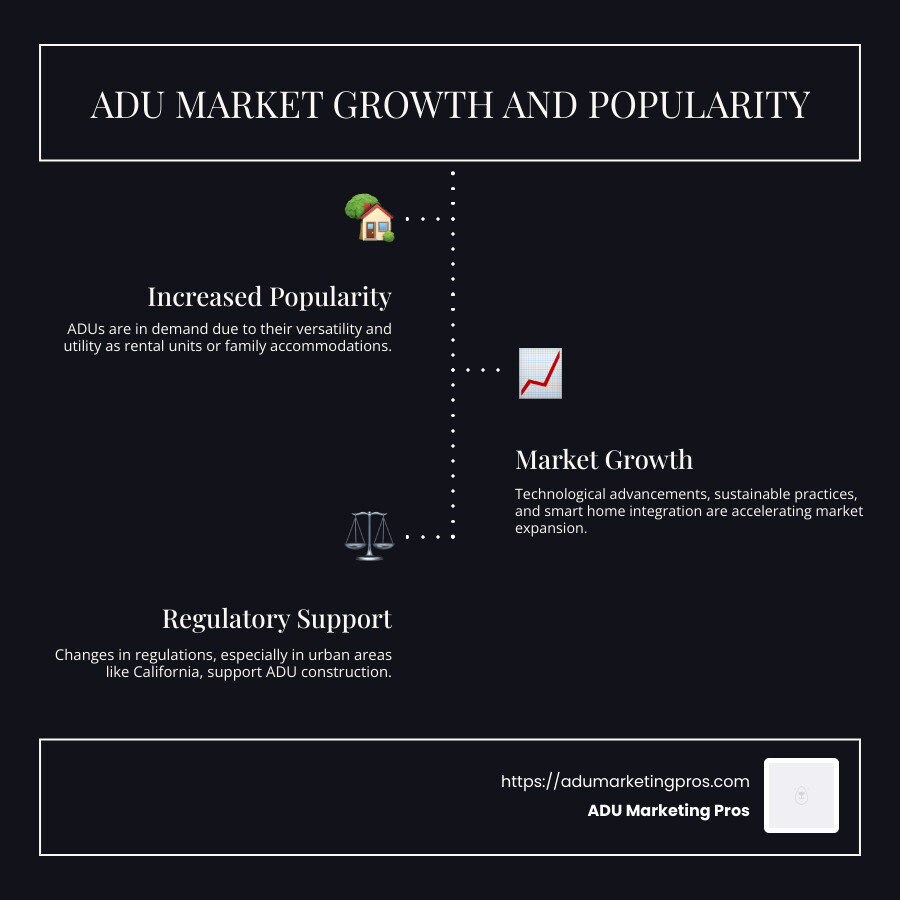
Understanding the ADU Market
The demand for Accessory Dwelling Units (ADUs) is skyrocketing, driven by a combination of housing shortages and the growing need for flexible living spaces. These compact, yet versatile, units are becoming a vital part of the solution to urban housing challenges.
ADU Demand and Housing Shortages
ADUs are a hot topic because they address the pressing issue of housing shortages in many urban areas. With cities like Los Angeles experiencing a crunch in available housing, ADUs provide a practical and efficient way to increase living space without the need for expansive new developments. By allowing homeowners to add rental units or extra family space to their existing properties, ADUs effectively use available land.
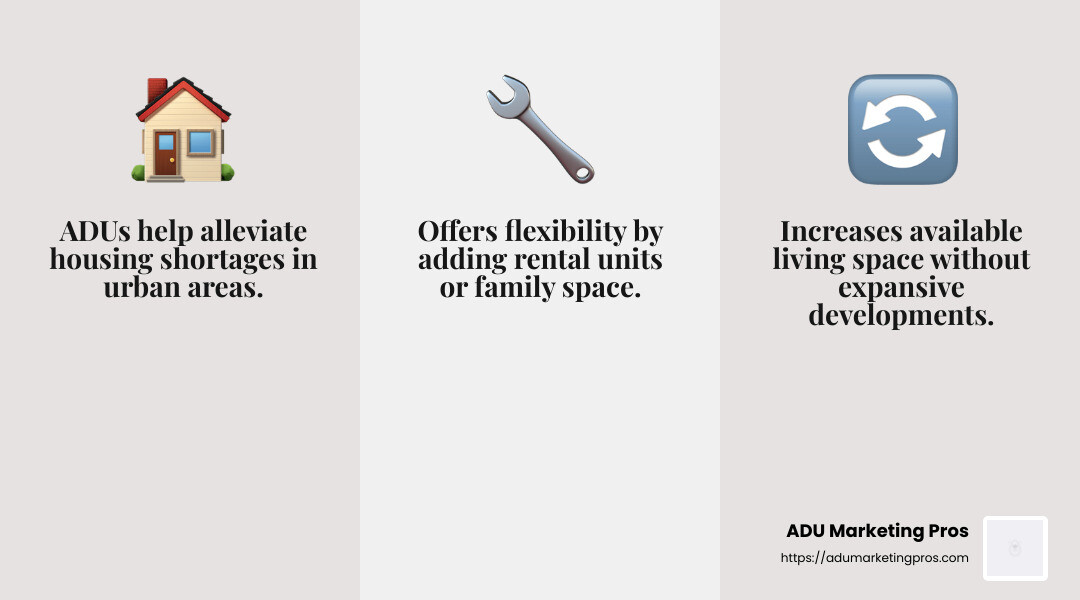
Flexible Living Spaces
Today’s homeowners crave flexibility, and ADUs deliver just that. These units can serve various purposes—from rental income generators to housing for aging parents or young adults returning home. This adaptability makes them an attractive option for many property owners.
Furthermore, the potential for multigenerational living is a significant draw. Families can stay close while maintaining separate living quarters, which is increasingly desirable in today’s society. ADUs can accommodate evolving family dynamics, providing a balance of proximity and privacy.
Market Dynamics and Growth
The ADU market is not just expanding; it’s evolving. Technological advancements in prefabricated and modular construction are making ADUs more accessible and affordable. Innovations in sustainable building materials and smart home technologies further improve their appeal, aligning with consumer preferences for eco-friendly and tech-savvy homes.
In regions with supportive zoning regulations, the growth trajectory of ADUs is even steeper. Local policies that favor ADU development are crucial in shaping the market landscape, allowing for more widespread adoption and integration into community planning.
Overall, the ADU market represents a significant opportunity for construction companies. By understanding and tapping into these market dynamics, businesses can effectively cater to the rising demand for these versatile living spaces.
Marketing for Construction Companies of Accessory Dwelling Units (ADU)
ADU Construction
The construction of Accessory Dwelling Units (ADUs) is a booming business, especially in urban areas like Los Angeles where housing shortages are a pressing issue. ADUs offer a solution by utilizing existing land more efficiently. Construction companies specializing in ADUs can tap into this demand by showcasing their expertise in building these versatile units.
ADUs can range from detached units to garage conversions, and even basement apartments. The variety allows construction companies to offer flexible solutions custom to different homeowner needs, whether it’s for rental income or multigenerational living.
Digital Marketing Strategies
To effectively reach potential clients, construction companies need to accept digital marketing strategies. This means having a strong online presence and using digital tools to attract and engage customers. Here are some strategies to consider:
-
Online Listings: Platforms like Zillow and Apartments.com are essential for showcasing your ADU projects. High-quality images and detailed descriptions can make your listings stand out.
-
Social Media: Use Instagram and Facebook to share photos, videos, and client testimonials. Social media is a powerful way to build your brand and connect with potential clients.
-
SEO and PPC: Optimize your website for search engines to ensure that when someone searches for “ADU construction in Los Angeles,” your company appears at the top. Pay-per-click (PPC) advertising can also drive targeted traffic to your site.
Niche Markets
Identifying and targeting niche markets can set your construction company apart. Consider focusing on specific customer segments who are more likely to invest in ADUs:
-
Eco-conscious Homeowners: With advancements in sustainable building materials, you can market ADUs that are environmentally friendly, appealing to those who prioritize green living.
-
Tech-savvy Clients: Highlight smart home features in your ADUs, such as automated lighting and security systems, to attract tech enthusiasts.
-
Multigenerational Families: Emphasize the benefits of ADUs for families looking to house aging parents or young adults, offering both proximity and privacy.
By tailoring your marketing efforts to these niche markets, you can position your company as a leader in the ADU construction industry.
The ADU market is ripe with opportunities. Construction companies that leverage digital marketing and target niche markets will be well-positioned to capitalize on the growing demand for these versatile living spaces.
Next, we’ll explore how to leverage digital platforms to further improve your marketing efforts.
Step 1: Leverage Digital Platforms
In marketing for construction companies of accessory dwelling units (ADU), digital platforms are your best friends. They help you reach more people without breaking the bank. Let’s break it down:
Online Listings
Think of online listings as your digital storefront. Platforms like Zillow and Apartments.com are where potential clients first see your work. Make sure your listings are top-notch:
-
Professional Photos: Invest in high-quality images. A picture is worth a thousand words, and in real estate, it can be worth even more in dollars.
-
Detailed Descriptions: Tell a story about the ADU. Is it a cozy retreat or a modern urban dwelling? Be descriptive to paint a picture for potential buyers.
-
Key Features: Highlight unique features like smart home technology or eco-friendly materials. These can set your ADUs apart from the competition.
Social Media
Social media is a powerful tool for connecting with potential clients. Platforms like Instagram and Facebook allow you to showcase your projects and engage with your audience.
-
Visual Content: Share stunning photos and videos of your ADUs. Use Instagram Stories or Facebook Live for virtual tours. This gives potential clients a feel for the space without having to visit in person.
-
Engagement: Respond to comments and messages quickly. Building a relationship with your audience can lead to more inquiries and potential sales.
-
Local Highlights: Feature nearby amenities or community events. This not only promotes the ADU but also the lifestyle that comes with it.
Virtual Tours
Virtual tours are a game-changer in real estate marketing. They allow potential buyers to walk through the ADU from the comfort of their home, making it easier for them to envision living there.
-
360-Degree Tours: Use technology to create immersive experiences. This can make your listings more attractive and help buyers feel more connected to the property.
-
Interactive Elements: Add clickable features in your virtual tours that highlight unique aspects of the ADU, such as energy-efficient appliances or smart home systems.
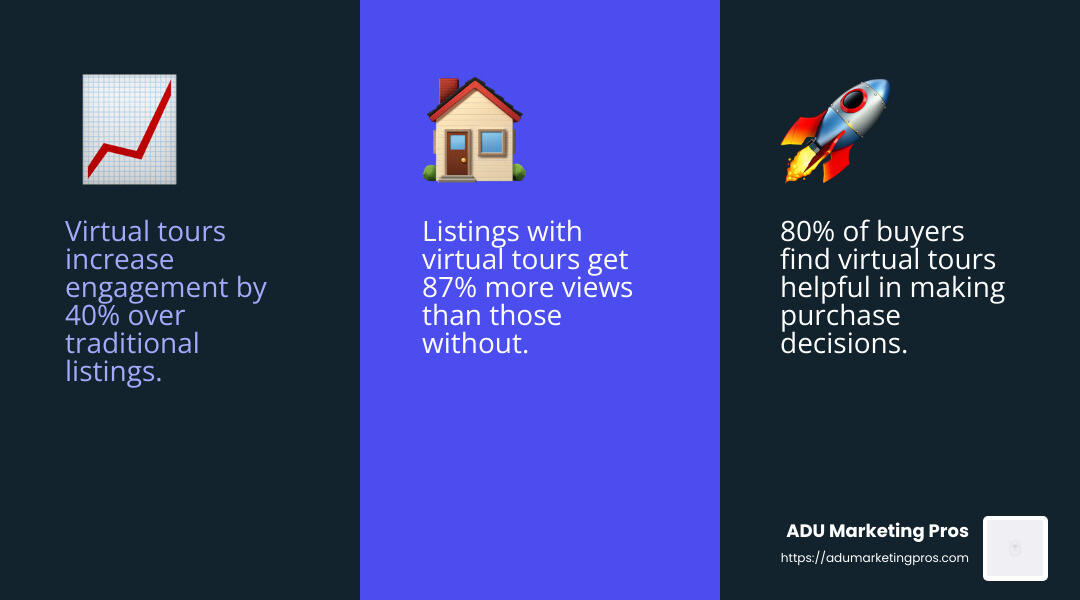
Incorporating these digital strategies will improve your reach and engagement. Next, we’ll dive into how highlighting unique selling points can further boost your marketing efforts.
Step 2: Highlight Unique Selling Points
When it comes to marketing for construction companies of accessory dwelling units (ADU), highlighting what makes your ADUs special can make all the difference. Here are three key selling points that can captivate potential buyers:
Property Value Increase
ADUs aren’t just additional living spaces; they can significantly boost property value. According to recent studies, properties with ADUs can see a value increase of up to 35%. This is because they offer more living space and potential for rental income, making them attractive to buyers and investors alike.
Rental Income
One of the most compelling aspects of ADUs is their potential for generating rental income. In urban areas, where housing demand is high, ADUs can be rented out for substantial monthly income. A well-located, furnished ADU can command higher rental rates, especially if it offers amenities like a private entrance, modern appliances, and a cozy living space. Highlighting rental income potential can attract investors looking for a steady revenue stream.
Multigenerational Living
ADUs are perfect for multigenerational living, catering to families who want to stay close while maintaining privacy. They provide an ideal setup for housing aging parents or young adults not yet ready to move out on their own. By emphasizing the flexibility and convenience of multigenerational living, you can appeal to families looking for long-term housing solutions that accommodate changing needs.
By focusing on these unique selling points, you can create a compelling narrative around your ADU projects that resonates with a diverse range of buyers. Next, we’ll explore how using local knowledge can further improve your marketing strategy.
Step 3: Use Local Knowledge
Understanding and leveraging local knowledge is crucial when marketing for construction companies of accessory dwelling units (ADU). This involves navigating zoning regulations, permitting processes, and local policies, all of which can significantly impact your ADU projects.
Zoning Regulations
Zoning regulations are the rules that dictate how land can be used in different areas. These can vary widely from one city to another and can greatly affect where and how you can build ADUs. For instance, in Los Angeles, recent zoning changes have made it easier to add ADUs to properties, reflecting a growing trend to accommodate housing shortages. Knowing these regulations inside and out helps you avoid costly mistakes and ensures your projects are compliant from the start.
Permitting
The permitting process can be a maze of paperwork and approvals. Each locality will have its own set of requirements and timelines. For example, some areas might require design reviews or neighborhood notifications, while others might streamline the process to encourage more ADU development. Partnering with experts who specialize in guiding homeowners through these processes can be invaluable. They can help simplify permit acquisition, saving time and reducing stress.
Local Policies
Local policies often reflect the unique needs and priorities of a community. For example, some cities may offer incentives for building environmentally friendly ADUs, such as tax breaks or expedited permits. Others might focus on affordable housing initiatives, providing grants or subsidies for ADU projects that meet certain criteria. Being aware of these policies not only aids in compliance but also opens up opportunities to market your ADUs as aligned with community goals.
By using local knowledge effectively, you can position your ADU projects as not only viable and compliant but also as valuable additions to the community. This approach not only helps avoid legal pitfalls but also improves your reputation and appeal among potential clients. Next, we’ll dig into the power of creating compelling visual content to further boost your marketing efforts.
Step 4: Create Compelling Visual Content
Creating compelling visual content is a game-changer in marketing for construction companies of accessory dwelling units (ADU). Great visuals can captivate potential clients and highlight the unique features of your ADU projects.
High-Quality Photos
High-quality photos are essential for making a strong first impression. They showcase the craftsmanship and design of your ADUs. Invest in professional photography to ensure your images are sharp, well-lit, and capture the essence of the space. Highlight key features like modern kitchens, spacious living areas, or unique architectural details. This helps potential buyers or renters visualize themselves in the space.
Drone Footage
Drone footage offers a bird’s-eye view that can set your listings apart. It provides a comprehensive look at the property layout and surrounding areas. Use drones to capture the full scope of the property, including potential ADU sites. This perspective can highlight the spaciousness and potential of the land, making it more appealing to buyers interested in development opportunities.
Design Renderings
Design renderings are incredibly useful for showcasing potential ADU projects. They provide a visual representation of what the finished product could look like. Renderings help clients imagine the possibilities and see the value in investing in an ADU. Include multiple angles and interior layouts to give a full picture of the potential living space. This can be particularly effective in areas with strict zoning regulations, as it allows clients to see compliant design options.
By focusing on high-quality photos, drone footage, and design renderings, you can create a compelling visual narrative that highlights the benefits and potential of ADUs. These visuals not only attract attention but also help in conveying the unique selling points of your projects. Up next, we’ll explore how engaging with the community can further improve your marketing strategy.
Step 5: Engage with the Community
Engaging with the community is a crucial step in marketing for construction companies of accessory dwelling units (ADU). Building strong local relationships can significantly boost your visibility and credibility.
Local Events
Participating in local events is a fantastic way to connect with potential clients and showcase your expertise. Consider setting up a booth at community fairs or home improvement expos. These events provide an opportunity to display your ADU projects, share brochures, and answer questions. You can even host workshops or seminars to educate the public about the benefits of ADUs, such as increased property value and rental income.
Community Platforms
Use community platforms like neighborhood Facebook groups or local online forums. These platforms are excellent for sharing updates about your projects, posting photos, and engaging in conversations about ADUs. By being active and helpful in these spaces, you can establish yourself as a trusted local expert.
Real Estate Agents
Collaborating with real estate agents can open doors to a wider audience. Agents often have a deep understanding of local market trends and can connect you with potential buyers interested in properties with ADU potential. Offer to provide them with detailed information about your ADU projects, including design renderings and zoning compliance. This partnership can lead to referrals and help you tap into new client bases.
By actively engaging with the community through local events, community platforms, and real estate agents, you can create a robust network that supports and promotes your ADU services. This approach not only strengthens your market presence but also fosters trust and long-term relationships with potential clients.
Next, we’ll address some of the most frequently asked questions about ADU marketing.
Frequently Asked Questions about ADU Marketing
What is the most expensive part of building an ADU?
Construction costs are typically the most significant expense in building an ADU. These costs can vary widely depending on the design, materials, and whether the unit is attached or detached. Sitework—such as preparing the land, setting foundations, and connecting utilities—is another major factor. Additionally, the structure itself, especially if it involves high-end materials or unique architectural features, can drive up costs. Understanding these components helps potential ADU builders budget effectively and avoid unexpected expenses.
Are ADUs profitable?
Yes, ADUs can be quite profitable. They offer multiple benefits, such as a property value increase and the potential for rental income. In urban areas, where housing demand is high, ADUs can command premium rental prices. This is particularly true in cities with housing shortages, where ADUs provide much-needed flexible living spaces. By offering either long-term or short-term rental options, homeowners can generate a steady income stream, making ADUs a financially attractive investment.
How big is the ADU market in the US?
The ADU market in the US is growing rapidly. The demand for flexible living solutions is on the rise, driven by factors like housing shortages and the appeal of multigenerational living. According to industry reports, the market size is expanding, with a strong growth forecast. The compound annual growth rate (CAGR) for ADUs indicates a positive trend, as more homeowners and investors recognize the benefits of adding these units to their properties. This growth is fueled by technological advancements, such as prefabricated and modular units, which make ADU construction more accessible and efficient.
Conclusion
At ADU Marketing Pros, we specialize in crafting marketing for construction companies of accessory dwelling units (ADU). Our custom solutions focus on helping ADU construction and architecture firms stand out in a crowded market. We emphasize expertise over price, ensuring our clients can attract high-quality leads and grow their revenue.
Our approach is rooted in a deep understanding of the ADU market’s unique challenges and opportunities. By leveraging targeted SEO, PPC, and social media strategies, we position our clients as leaders in the industry. Our specialized solutions go beyond generic marketing tactics, focusing on the specific needs and behaviors of ADU buyers and investors.
The result? Measurable growth for our clients. Our strategies are designed to deliver consistent leads and improve brand recognition. By continuously adapting to market changes and consumer preferences, we ensure our clients can capitalize on the booming ADU sector.
Ready to lift your ADU business with specialized marketing solutions? Find how we can help you grow.

